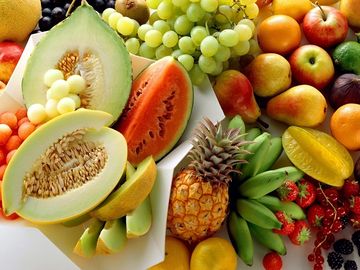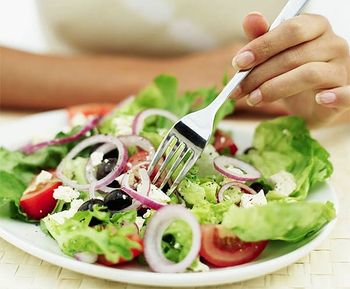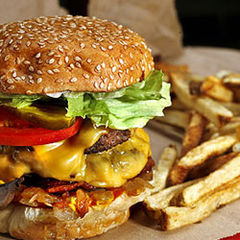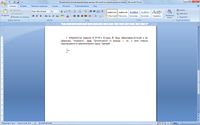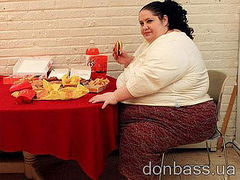Wiki-статья "Healthy Food": различия между версиями
Wiki (обсуждение | вклад) м (Защищена страница «Wiki-статья "Healthy Food"» ([edit=autoconfirmed] (бессрочно) [move=autoconfirmed] (бессрочно))) |
|||
| (не показано 40 промежуточных версий 5 участников) | |||
| Строка 16: | Строка 16: | ||
== Цели исследования == | == Цели исследования == | ||
| − | + | Найти и изучить информацию о здоровой пище и о тех продуктах которые нужно избегать. | |
| − | + | Провести опрос, как питаются учащиеся. | |
| + | |||
| + | Оформить результаты исследования. | ||
== Ход исследования == | == Ход исследования == | ||
| − | 1. | + | 1. Поиск материала по данным вопросам. |
| + | |||
| + | 2. Обсуждение найденной информации. | ||
| + | |||
| + | 3. Найти соотвествующие картинки. | ||
| − | + | 4. Оформить полученные результаты в виде wiki-статьи. | |
| − | + | 5. Анализ проделанной работы. | |
== Результаты исследования == | == Результаты исследования == | ||
| Строка 32: | Строка 38: | ||
Eating is one the most important events in everyone’s life. We enjoy eating - it’s part of who we are and part of our culture; in fact, eating is the hottest universal topic of all times. We depend on eating: the foods we eat are the sole source of our energy and nutrition. We know so much about eating: we are born with the desire to eat and grown up with rich traditions of eating. But we also know so little about eating - about how the foods we eat everyday affect our health. We are more confused than ever about the link between diet and health: margarine is healthier than butter or not; a little alcohol will keep heart attacks at bay but cause breast cancer; dietary vitamin antioxidants can prevent lung cancer or can not. Eating is a paradox and a mystery that our ancestors tried and modern scientists are trying to solve. | Eating is one the most important events in everyone’s life. We enjoy eating - it’s part of who we are and part of our culture; in fact, eating is the hottest universal topic of all times. We depend on eating: the foods we eat are the sole source of our energy and nutrition. We know so much about eating: we are born with the desire to eat and grown up with rich traditions of eating. But we also know so little about eating - about how the foods we eat everyday affect our health. We are more confused than ever about the link between diet and health: margarine is healthier than butter or not; a little alcohol will keep heart attacks at bay but cause breast cancer; dietary vitamin antioxidants can prevent lung cancer or can not. Eating is a paradox and a mystery that our ancestors tried and modern scientists are trying to solve. | ||
| − | + | [[Изображение:Food.jpg|360px]] | |
| + | |||
| + | '''There is a list of healthy foodstuffs and there influence on:''' | ||
| + | |||
| + | '''Fruits''' | ||
| + | |||
| + | - Apricots | ||
| + | |||
| + | The Power: Beta-carotene, which helps prevent free-radical damage and protect the eyes. The body also turns beta-carotene into vitamin A, which may help ward off some cancers, especially of the skin. One apricot has 17 calories, 0 fat, 1 gram of fiber. Snacks on them dried, or if you prefer fresh, buy when still firm; once they soften, they lose nutrients. | ||
| + | |||
| + | - Avocados | ||
| + | |||
| + | The Power: Oleic acid, an unsaturated fat that helps lower overall cholesterol and raise levels of HDL, plus a good dose of fiber. One slice has 81 calories, 8 grams of fat and 3 grams of fiber. Try a few slices instead of mayonnaise to dress up your next burger. | ||
| + | |||
| + | - Raspberries | ||
| + | |||
| + | The Power: Ellagic acid, which helps stall cancer-cell growth. These berries are also packed with vitamin C and are high in fiber, which helps prevent high cholesterol and heart disease. A cup has only 60 calories, 1 gram of fat and 8 grams of fiber. Top plain low-fat yogurt or oatmeal (another high fiber food) with fresh berries. | ||
| + | |||
| + | - Cranberry Juice | ||
| + | |||
| + | The Power: Helps fight bladder infections by preventing harmful bacteria from growing. A cup has 144 calories, 0 grams of fat and 0 fiber. Buy 100 percent juice concentrate and use it to spice up your daily H20 without adding sugar. | ||
| + | |||
| + | - Tomato | ||
| + | |||
| + | The Power: Lycopene, one of the strongest carotenoids, acts as an antioxidant. Research shows that tomatoes may cut the risk of bladder, stomach and colon cancers in half if eaten daily. A tomato has 26 calories, 0 fat and 1 gram of fiber. Drizzle fresh slices with olive oil, because lycopene is best absorbed when eaten with a little fat. | ||
| + | |||
| + | - Figs | ||
| + | |||
| + | The Power: A good source of potassium and fiber, figs also contain vitamin B6, which is responsible for producing mood-boosting serotonin, lowering cholesterol and preventing water retention. The Pill depletes B6, so if you use this method of birth control, make sure to get extra B6 in your diet. One fig has 37 to 48 calories, 0 fat and 2 grams of fiber. (Cookie lovers - fig bars have around 56 calories, 1 gram of fat and 1 gram of fiber per cookie). Fresh figs are delicious simmered alongside a pork tenderloin and the dried variety make a great portable gym snack. | ||
| + | |||
| + | - Lemons and Limes | ||
| + | |||
| + | The Power: Limonene, furocoumarins and vitamin C, all of which help prevent cancer. A wedge has 2 calories, 0 fat and 0 fiber. Buy a few of each and squeeze over salads, fish, beans and vegetables for fat free flavor. See also: Beneficial Bytes: Lemons and Limes. | ||
| + | |||
| + | '''Vegetables''' | ||
| + | |||
| + | - Onions | ||
| + | |||
| + | The Power: Quercetin is one of the most powerful flavonoids (natural plant antioxidants). Studies show it helps protect against cancer. A cup (chopped) has 61 calories, 0 fat and 3 grams of fiber. Chop onions for the maximum phytonutrient boost, or if you hate to cry, roast them with a little olive oil and serve with rice or other vegetables. | ||
| + | |||
| + | - Artichokes | ||
| − | + | The Power: These odd-looking vegetables contain silymarin, an antioxidant that helps prevent skin cancer, plus fiber to help control cholesterol. One medium artichoke has 60 calories, 0 fat and 7 grams of fiber. Steam over boiling water for 30 to 40 minutes. Squeeze lemon juice on top, then pluck the leaves off with your fingers and use your teeth to scrape off the rich-tasting skin. When you get to the heart, you have found the best part! | |
| − | + | - Ginger | |
| − | + | The Power: Gingerols may help reduce queasiness; other compounds may help ward off migraines and arthritis pain by blocking inflammation-causing prostaglandins. A teaspoon of fresh gingerroot has only 1 calorie, 0 fat and 0 fiber. Peel the tough brown skin and slice or grate into a stir-fry. | |
| − | |||
| − | + | - Broccoli | |
| − | |||
| + | The Power: Indole-3-carbinol and sulforaphane, which help protect against breast cancer. Broccoli also has lots of vitamin C and beta-carotene. One cup (chopped) has 25 calories, 0 fat and 3 grams of fiber. Don't overcook broccoli - instead, microwave or steam lightly to preserve phytonutrients. Squeeze fresh lemon on top for a zesty and taste, added nutrients and some vitamin C. | ||
| − | + | - Garlic | |
| − | |||
| − | + | The Power: The sulfur compounds that give garlic its pungent flavor can also lower LDL ("bad") cholesterol, lower blood pressure and even reduce your risk of stomach and colon cancer. A clove has 4 calories, 0 fat and 0 fiber. Bake a whole head for 15 to 20 minutes, until soft and sweet and spread on bread instead of butter. | |
| − | |||
| − | + | '''Grains, Beans, Dairy and Nuts''' | |
| − | |||
| − | + | - Peanuts | |
| − | |||
| − | + | The Power: Studies show that peanuts or other nuts (which contain mostly unsaturated "good" fat) can lower your heart-disease risk by over 20 percent. One ounce has 166 calories, 14 grams of fat and 2 grams of fiber. Keep a packet in your briefcase, gym bag or purse for a protein-packed post-workout nosh or an afternoon pick me up that will satisfy you until supper, or chop a few into a stir-fry for a Thai accent. See also: The Nut Case | |
| − | |||
| − | + | - Pinto Beans | |
| − | |||
| − | + | The Power: A half cup has more than 25 percent of your daily requirement of folate, which helps protect against heart disease and reduces the risk of birth defects. A half-cup (canned) has 103 calories, 1 gram of fat and 6 grams of fiber. Drain a can, rinse and toss into a pot of vegetarian chili. | |
| − | |||
| − | |||
| − | + | - Yogurt | |
| − | |||
| − | + | The Power: Bacteria in active-culture yogurt helps prevent yeast infections; calcium strengthens bones. A cup has 155 calories, 4 grams of fat, 0 grams of fiber. Get the plain kind and mix in your own fruit to keep calories and sugar down. If you are lactose intolerant, never fear -- yogurt should not bother your tummy. | |
| − | |||
| − | + | - Skim Milk | |
| − | |||
| − | + | The Power: Riboflavin (a.k.a. vitamin B2) is important for good vision and along with vitamin A might help improve eczema and allergies. Plus, you get calcium and vitamin D, too. One cup has 86 calories, 0 fat and 0 fiber. If you are used to high fat milk, don't go cold turkey; instead, mix the two together at first. Trust this fact: In a week or two you won't miss it! | |
| − | |||
| − | + | '''Seafood''' | |
| − | |||
| − | + | - Salmon | |
| − | |||
| − | + | The Power: Cold-water fish like salmon, mackerel and tuna are the best sources of omega-3 fatty acids, which help reduce the risk of cardiac disease. A 3-ounce portion (cooked) has 127 calories, 4 grams of fat, 0 fiber. Brush fillets with ginger-soy marinade and grill or broil until fish flakes easily with a fork. | |
| − | |||
| − | + | - Crab | |
| − | |||
| − | + | The Power: A great source of vitamin B12 and immunity-boosting zinc. A 3-ounce portion has 84 calories, 1 gram of fat, 0 fiber. The "crab" in sushi is usually made from fish; buy it canned instead and make your own crab cakes. See also: Fish and Seafood Recipes | |
| − | |||
| − | |||
| − | + | [[Изображение:Onion.jpg|350px]] | |
| − | |||
| − | |||
| − | |||
| − | + | '''Harm of the fat and a spicy food''' | |
| − | |||
| − | + | Harmful substances after fat food lead to | |
| − | + | - nausea, vomiting, | |
| − | + | - diarrhea, | |
| − | |||
| − | + | - feeling sick, | |
| − | |||
| − | + | - aggravation of inflammatory processes | |
| − | |||
| − | |||
| − | + | - can cause and Alzheimer's disease. | |
| − | |||
| − | + | !avoid a big chunk of a pizza or a hot sandwich with cheese | |
| − | |||
| − | + | !avoid chips with spices or salty crackers | |
| − | |||
| + | !avoid dark chocolate with caffeine | ||
| − | + | !avoid the Chinese snack and other frozen semifinished products | |
| − | + | [[Изображение:Fat.jpg|240px]] | |
| − | |||
| − | + | - Choose liquid oils for cooking instead of solid fats that can be high in saturated and trans fats. Olive oil is always a good choice. | |
| − | + | - Choose water, natural fruit and vegetable juices instead of sodas and empty calorie drinks. Avoid drinks with artificial sweeteners. | |
| − | + | - Avoid buying snack foods and desserts like chips, cookies, cakes, and full-fat ice cream. | |
| − | + | - Consider trying vegetarian recipes. Sometimes you just don't know how good vegetables can taste until you come across that perfect recipe. | |
| Строка 167: | Строка 183: | ||
[[Изображение:Samostoyalka2.jpg|360px]] | [[Изображение:Samostoyalka2.jpg|360px]] | ||
| + | |||
| + | |||
| + | Нами было проведено исследование по выявлению того, как учащиеся питаются. | ||
| + | |||
| + | '''Вопросы исследования:''' | ||
| + | |||
| + | 1. Завтракаете ли вы? | ||
| + | |||
| + | 2. Часто ли вы пьете кофе? | ||
| + | |||
| + | 3. Часто ли вы употербляете шоколад и сахар? | ||
| + | |||
| + | 4. Входят ли молочные продукты в рацион вашего питания? | ||
| + | |||
| + | 5. Часто ли вы питаетесь в местах быстрого обслуживания? | ||
| + | |||
| + | 6. Едите ли вы на ночь? | ||
| + | |||
| + | 7. Сколько раз в день вы принимаете пищу? | ||
| + | |||
| + | 8. Пьете ли вы витамины? | ||
| + | |||
| + | Результаты исследования: | ||
| + | |||
| + | 1. 70% - 14 человек | ||
| + | |||
| + | 2. 40% - 8 человек | ||
| + | |||
| + | 3. 90% - 18 человек | ||
| + | |||
| + | 4. 60% - 12 человек | ||
| + | |||
| + | 5. 85% - 17 человек | ||
| + | |||
| + | 6. 60% - человек | ||
| + | |||
| + | 7. 3 раза в день - 25% - 5 человек; 4 раза - 20% - 4 человека; 5 раз - 55% - 11 человек | ||
| + | |||
| + | 8. 30% - 6 человек | ||
| + | |||
| + | Из полученных нами результатов, мы выявили, что большое влияние на здоровье учащихся оказывает фаст фуд, который в последнее время встречается повсюду, а данное питание не относится к здоровой пище. | ||
| + | Также многие учащиеся переедают на ночь, что в свою очередь пагубно влияет на организм человека, так как во время сна организм не получает надлежащего отдыха. | ||
| + | Стоит отметить, что частое употребление кофе в возрасте 14-15 лет вредит здоровью растущего организма. А в сочетание с употреблением шоколада это оказывает еще большее негативное влияние, и от шоколада набирают лишний вес. | ||
| + | Учащиеся мало употребляют витаминов, а зачастую именно нехватка определенных витаминов приводит к ослаблению иммунитета и заболеваниям. | ||
| + | |||
| + | '''EAT AT PLEASURE, DRINK WITH MEASURE''' | ||
| + | |||
| + | [[Файл:1.jpg|200px]] | ||
| + | [[Файл:Eat.jpg|240px]] | ||
== Выводы == | == Выводы == | ||
| + | |||
| + | Having learned the information we understand the importance of correct eating. It is very important for us to eat in such way that we could think clearer and our brains work faster. Only eating the right way allow us it. We won't have any troubles with our health following the pieces of advice mentioned above. We will always be in a good shape and in a good mood. That is why we should eat for living but not to live for eating. | ||
== Полезные ресурсы == | == Полезные ресурсы == | ||
Текущая версия от 04:20, 24 ноября 2011
Название проекта
"Healthy Food"
Авторы проекта
Предмет, класс
Английский язык
9 класс
Проблемный вопрос
Есть чтобы жить или жить чтобы есть?
Цели исследования
Найти и изучить информацию о здоровой пище и о тех продуктах которые нужно избегать.
Провести опрос, как питаются учащиеся.
Оформить результаты исследования.
Ход исследования
1. Поиск материала по данным вопросам.
2. Обсуждение найденной информации.
3. Найти соотвествующие картинки.
4. Оформить полученные результаты в виде wiki-статьи.
5. Анализ проделанной работы.
Результаты исследования
Eating is one the most important events in everyone’s life. We enjoy eating - it’s part of who we are and part of our culture; in fact, eating is the hottest universal topic of all times. We depend on eating: the foods we eat are the sole source of our energy and nutrition. We know so much about eating: we are born with the desire to eat and grown up with rich traditions of eating. But we also know so little about eating - about how the foods we eat everyday affect our health. We are more confused than ever about the link between diet and health: margarine is healthier than butter or not; a little alcohol will keep heart attacks at bay but cause breast cancer; dietary vitamin antioxidants can prevent lung cancer or can not. Eating is a paradox and a mystery that our ancestors tried and modern scientists are trying to solve.
There is a list of healthy foodstuffs and there influence on:
Fruits
- Apricots
The Power: Beta-carotene, which helps prevent free-radical damage and protect the eyes. The body also turns beta-carotene into vitamin A, which may help ward off some cancers, especially of the skin. One apricot has 17 calories, 0 fat, 1 gram of fiber. Snacks on them dried, or if you prefer fresh, buy when still firm; once they soften, they lose nutrients.
- Avocados
The Power: Oleic acid, an unsaturated fat that helps lower overall cholesterol and raise levels of HDL, plus a good dose of fiber. One slice has 81 calories, 8 grams of fat and 3 grams of fiber. Try a few slices instead of mayonnaise to dress up your next burger.
- Raspberries
The Power: Ellagic acid, which helps stall cancer-cell growth. These berries are also packed with vitamin C and are high in fiber, which helps prevent high cholesterol and heart disease. A cup has only 60 calories, 1 gram of fat and 8 grams of fiber. Top plain low-fat yogurt or oatmeal (another high fiber food) with fresh berries.
- Cranberry Juice
The Power: Helps fight bladder infections by preventing harmful bacteria from growing. A cup has 144 calories, 0 grams of fat and 0 fiber. Buy 100 percent juice concentrate and use it to spice up your daily H20 without adding sugar.
- Tomato
The Power: Lycopene, one of the strongest carotenoids, acts as an antioxidant. Research shows that tomatoes may cut the risk of bladder, stomach and colon cancers in half if eaten daily. A tomato has 26 calories, 0 fat and 1 gram of fiber. Drizzle fresh slices with olive oil, because lycopene is best absorbed when eaten with a little fat.
- Figs
The Power: A good source of potassium and fiber, figs also contain vitamin B6, which is responsible for producing mood-boosting serotonin, lowering cholesterol and preventing water retention. The Pill depletes B6, so if you use this method of birth control, make sure to get extra B6 in your diet. One fig has 37 to 48 calories, 0 fat and 2 grams of fiber. (Cookie lovers - fig bars have around 56 calories, 1 gram of fat and 1 gram of fiber per cookie). Fresh figs are delicious simmered alongside a pork tenderloin and the dried variety make a great portable gym snack.
- Lemons and Limes
The Power: Limonene, furocoumarins and vitamin C, all of which help prevent cancer. A wedge has 2 calories, 0 fat and 0 fiber. Buy a few of each and squeeze over salads, fish, beans and vegetables for fat free flavor. See also: Beneficial Bytes: Lemons and Limes.
Vegetables
- Onions
The Power: Quercetin is one of the most powerful flavonoids (natural plant antioxidants). Studies show it helps protect against cancer. A cup (chopped) has 61 calories, 0 fat and 3 grams of fiber. Chop onions for the maximum phytonutrient boost, or if you hate to cry, roast them with a little olive oil and serve with rice or other vegetables.
- Artichokes
The Power: These odd-looking vegetables contain silymarin, an antioxidant that helps prevent skin cancer, plus fiber to help control cholesterol. One medium artichoke has 60 calories, 0 fat and 7 grams of fiber. Steam over boiling water for 30 to 40 minutes. Squeeze lemon juice on top, then pluck the leaves off with your fingers and use your teeth to scrape off the rich-tasting skin. When you get to the heart, you have found the best part!
- Ginger
The Power: Gingerols may help reduce queasiness; other compounds may help ward off migraines and arthritis pain by blocking inflammation-causing prostaglandins. A teaspoon of fresh gingerroot has only 1 calorie, 0 fat and 0 fiber. Peel the tough brown skin and slice or grate into a stir-fry.
- Broccoli
The Power: Indole-3-carbinol and sulforaphane, which help protect against breast cancer. Broccoli also has lots of vitamin C and beta-carotene. One cup (chopped) has 25 calories, 0 fat and 3 grams of fiber. Don't overcook broccoli - instead, microwave or steam lightly to preserve phytonutrients. Squeeze fresh lemon on top for a zesty and taste, added nutrients and some vitamin C.
- Garlic
The Power: The sulfur compounds that give garlic its pungent flavor can also lower LDL ("bad") cholesterol, lower blood pressure and even reduce your risk of stomach and colon cancer. A clove has 4 calories, 0 fat and 0 fiber. Bake a whole head for 15 to 20 minutes, until soft and sweet and spread on bread instead of butter.
Grains, Beans, Dairy and Nuts
- Peanuts
The Power: Studies show that peanuts or other nuts (which contain mostly unsaturated "good" fat) can lower your heart-disease risk by over 20 percent. One ounce has 166 calories, 14 grams of fat and 2 grams of fiber. Keep a packet in your briefcase, gym bag or purse for a protein-packed post-workout nosh or an afternoon pick me up that will satisfy you until supper, or chop a few into a stir-fry for a Thai accent. See also: The Nut Case
- Pinto Beans
The Power: A half cup has more than 25 percent of your daily requirement of folate, which helps protect against heart disease and reduces the risk of birth defects. A half-cup (canned) has 103 calories, 1 gram of fat and 6 grams of fiber. Drain a can, rinse and toss into a pot of vegetarian chili.
- Yogurt
The Power: Bacteria in active-culture yogurt helps prevent yeast infections; calcium strengthens bones. A cup has 155 calories, 4 grams of fat, 0 grams of fiber. Get the plain kind and mix in your own fruit to keep calories and sugar down. If you are lactose intolerant, never fear -- yogurt should not bother your tummy.
- Skim Milk
The Power: Riboflavin (a.k.a. vitamin B2) is important for good vision and along with vitamin A might help improve eczema and allergies. Plus, you get calcium and vitamin D, too. One cup has 86 calories, 0 fat and 0 fiber. If you are used to high fat milk, don't go cold turkey; instead, mix the two together at first. Trust this fact: In a week or two you won't miss it!
Seafood
- Salmon
The Power: Cold-water fish like salmon, mackerel and tuna are the best sources of omega-3 fatty acids, which help reduce the risk of cardiac disease. A 3-ounce portion (cooked) has 127 calories, 4 grams of fat, 0 fiber. Brush fillets with ginger-soy marinade and grill or broil until fish flakes easily with a fork.
- Crab
The Power: A great source of vitamin B12 and immunity-boosting zinc. A 3-ounce portion has 84 calories, 1 gram of fat, 0 fiber. The "crab" in sushi is usually made from fish; buy it canned instead and make your own crab cakes. See also: Fish and Seafood Recipes
Harm of the fat and a spicy food
Harmful substances after fat food lead to - nausea, vomiting,
- diarrhea,
- feeling sick,
- aggravation of inflammatory processes
- can cause and Alzheimer's disease.
!avoid a big chunk of a pizza or a hot sandwich with cheese
!avoid chips with spices or salty crackers
!avoid dark chocolate with caffeine
!avoid the Chinese snack and other frozen semifinished products
- Choose liquid oils for cooking instead of solid fats that can be high in saturated and trans fats. Olive oil is always a good choice.
- Choose water, natural fruit and vegetable juices instead of sodas and empty calorie drinks. Avoid drinks with artificial sweeteners.
- Avoid buying snack foods and desserts like chips, cookies, cakes, and full-fat ice cream.
- Consider trying vegetarian recipes. Sometimes you just don't know how good vegetables can taste until you come across that perfect recipe.
HOW TO EAT CORRECTLY
Eat only at the table. Don’t eat on the couch or at the kitchen counter.
Don’t work while eating. Separate all of your activities from your meals, so you can concentrate on what and how much you’re eating.
Eat slowly and chew each bite completely to decrease your appetite.
Don’t eat anything for the last three or four hours of your day. Once you’ve had dinner, be done for the night.
Read labels carefully. Some low fat items are very high in calories.
Serve yourself normal portions of food. Three ounces of meat or a half cup of rice are plenty in one meal.
Eat three small meals and two snacks daily instead of two or three huge meals.
Don’t starve yourself! Skipping meals only tricks your body into thinking its survival is threatened, and it will hold onto its fat stores for dear life.
Don’t nibble on things throughout the day. Some tidbits contain hundreds of calories.
Use a smaller plate than usual for dinner. You’ll feel like you ate more than you actually did.
Normaly people’s needs of caffeine and sugar increase during the afternoon. Have some fruit, yogurt or crackers on hand to combat this.
Нами было проведено исследование по выявлению того, как учащиеся питаются.
Вопросы исследования:
1. Завтракаете ли вы?
2. Часто ли вы пьете кофе?
3. Часто ли вы употербляете шоколад и сахар?
4. Входят ли молочные продукты в рацион вашего питания?
5. Часто ли вы питаетесь в местах быстрого обслуживания?
6. Едите ли вы на ночь?
7. Сколько раз в день вы принимаете пищу?
8. Пьете ли вы витамины?
Результаты исследования:
1. 70% - 14 человек
2. 40% - 8 человек
3. 90% - 18 человек
4. 60% - 12 человек
5. 85% - 17 человек
6. 60% - человек
7. 3 раза в день - 25% - 5 человек; 4 раза - 20% - 4 человека; 5 раз - 55% - 11 человек
8. 30% - 6 человек
Из полученных нами результатов, мы выявили, что большое влияние на здоровье учащихся оказывает фаст фуд, который в последнее время встречается повсюду, а данное питание не относится к здоровой пище. Также многие учащиеся переедают на ночь, что в свою очередь пагубно влияет на организм человека, так как во время сна организм не получает надлежащего отдыха. Стоит отметить, что частое употребление кофе в возрасте 14-15 лет вредит здоровью растущего организма. А в сочетание с употреблением шоколада это оказывает еще большее негативное влияние, и от шоколада набирают лишний вес. Учащиеся мало употребляют витаминов, а зачастую именно нехватка определенных витаминов приводит к ослаблению иммунитета и заболеваниям.
EAT AT PLEASURE, DRINK WITH MEASURE
Выводы
Having learned the information we understand the importance of correct eating. It is very important for us to eat in such way that we could think clearer and our brains work faster. Only eating the right way allow us it. We won't have any troubles with our health following the pieces of advice mentioned above. We will always be in a good shape and in a good mood. That is why we should eat for living but not to live for eating.
